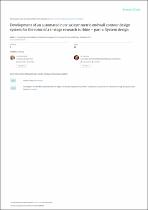 ResearchSpace
ResearchSpace
Development of an automated non-axisymmetric endwall contour design system for the rotor of a 1-stage research turbine - Part 2 Computed and experimental results
JavaScript is disabled for your browser. Some features of this site may not work without it.
- ResearchSpace
- →
- Research Publications/Outputs
- →
- Journal Articles
- →
- View Item
| dc.contributor.author |
Bergh, J

|
|
| dc.contributor.author |
Snedden, Glen C

|
|
| dc.contributor.author |
Reddy, D

|
|
| dc.date.accessioned | 2020-07-27T07:11:05Z | |
| dc.date.available | 2020-07-27T07:11:05Z | |
| dc.date.issued | 2020-01 | |
| dc.identifier.citation | Bergh, J., Snedden, G.C. & Reddy, D. 2020. Development of an automated non-axisymmetric endwall contour design system for the rotor of a 1-stage research turbine - Part 2 Computed and experimental results. Proceedings of the Institution of Mechanical Engineers Part A- Journal of power energy, pp. https://doi.org/10.1177/0957650919897769 | en_US |
| dc.identifier.issn | 0957-6509 | |
| dc.identifier.issn | 2041-2967 | |
| dc.identifier.uri | https://journals.sagepub.com/doi/abs/10.1177/0957650919897769 | |
| dc.identifier.uri | https://doi.org/10.1177/0957650919897769 | |
| dc.identifier.uri | http://hdl.handle.net/10204/11518 | |
| dc.description | Copyright 2020 Sage Journals. Due to copyright restrictions, the attached PDF file contains the pre-print of the full-text item. For access to the full-text item, please consult the publisher's website. https://journals.sagepub.com/doi/abs/10.1177/0957650919897769 | en_US |
| dc.description.abstract | Non-axisymmetric endwall contouring is a mechanism which attempts to reduce the negative effects of secondary ows in compressor and turbine blade rows by allowing the otherwise cylindrical turbine endwalls to take on threedimensional (and therefore non-axisymmetric) curvature in an attempt to favourably manipulate the endwall pressure elds which drive these ows. Since its initial conception, considerable effort has been expended in determining how to 1) maximise the positive effects of the technique, and as a natural consequence of this, 2) determine which metrics are best suited to quantifying the magnitudes of these ows. One of the issues which has confounded these attempts, has been the inadequacy of contemporary computational models to predict - by some accounts - some of the most apparently desirable quantities (such as loss), accurately. | en_US |
| dc.language.iso | en | en_US |
| dc.publisher | Sage Journals | en_US |
| dc.relation.ispartofseries | Workflow;23131 | |
| dc.subject | Eexperimental validation | en_US |
| dc.subject | Endwall contours | en_US |
| dc.subject | Non-axisymmetric | en_US |
| dc.subject | Turbines | en_US |
| dc.title | Development of an automated non-axisymmetric endwall contour design system for the rotor of a 1-stage research turbine - Part 2 Computed and experimental results | en_US |
| dc.type | Article | en_US |
| dc.identifier.apacitation | Bergh, J., Snedden, G. C., & Reddy, D. (2020). Development of an automated non-axisymmetric endwall contour design system for the rotor of a 1-stage research turbine - Part 2 Computed and experimental results. http://hdl.handle.net/10204/11518 | en_ZA |
| dc.identifier.chicagocitation | Bergh, J, Glen C Snedden, and D Reddy "Development of an automated non-axisymmetric endwall contour design system for the rotor of a 1-stage research turbine - Part 2 Computed and experimental results." (2020) http://hdl.handle.net/10204/11518 | en_ZA |
| dc.identifier.vancouvercitation | Bergh J, Snedden GC, Reddy D. Development of an automated non-axisymmetric endwall contour design system for the rotor of a 1-stage research turbine - Part 2 Computed and experimental results. 2020; http://hdl.handle.net/10204/11518. | en_ZA |
| dc.identifier.ris | TY - Article AU - Bergh, J AU - Snedden, Glen C AU - Reddy, D AB - Non-axisymmetric endwall contouring is a mechanism which attempts to reduce the negative effects of secondary ows in compressor and turbine blade rows by allowing the otherwise cylindrical turbine endwalls to take on threedimensional (and therefore non-axisymmetric) curvature in an attempt to favourably manipulate the endwall pressure elds which drive these ows. Since its initial conception, considerable effort has been expended in determining how to 1) maximise the positive effects of the technique, and as a natural consequence of this, 2) determine which metrics are best suited to quantifying the magnitudes of these ows. One of the issues which has confounded these attempts, has been the inadequacy of contemporary computational models to predict - by some accounts - some of the most apparently desirable quantities (such as loss), accurately. DA - 2020-01 DB - ResearchSpace DP - CSIR KW - Eexperimental validation KW - Endwall contours KW - Non-axisymmetric KW - Turbines LK - https://researchspace.csir.co.za PY - 2020 SM - 0957-6509 SM - 2041-2967 T1 - Development of an automated non-axisymmetric endwall contour design system for the rotor of a 1-stage research turbine - Part 2 Computed and experimental results TI - Development of an automated non-axisymmetric endwall contour design system for the rotor of a 1-stage research turbine - Part 2 Computed and experimental results UR - http://hdl.handle.net/10204/11518 ER - | en_ZA |





